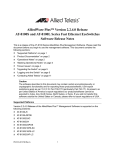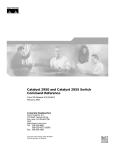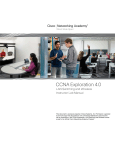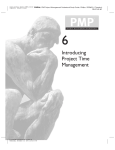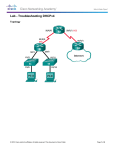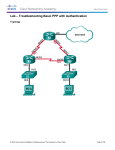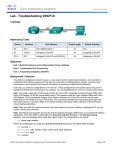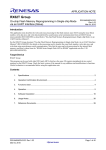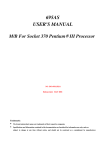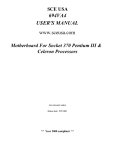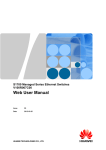Download Cisco WS-C2950SX-24 Technical data
Transcript
CertPrs8/CCNA® Cisco Certified Network Associate Study Guide/Richard Deal/149728-5/Chapter 12 Blind Folio 357 12 Initial Switch Configuration CERTIFICATION OBJECTIVES ch12.indd 357 12.01 2960 Overview 12.05 12.02 Switch Startup ✓ 12.03 Basic Switch Configuration 12.04 Basic Switch Operation and Verification Q&A Port Security Feature Two-Minute Drill Self Test 3/12/08 4:45:00 PM CertPrs8/CCNA® Cisco Certified Network Associate Study Guide/Richard Deal/149728-5/Chapter 12 358 Chapter 12: Initial Switch Configuration T he 2940, 2955, and 2960 series of switches are Cisco’s current desktop and workgroup switching solution; they replace the 1900 and 2950 switches. The new switches support Fast Ethernet and Gigabit Ethernet interfaces. This book, and the CCNA exam, focus on the end-of-sale 2950 and the newer 2960 switches, but the topics and configuration commands discussed in this chapter apply to all of Cisco’s Catalyst switches running the Internetwork Operating System (IOS). CERTIFICATION OBJECTIVE 12.01 2960 Overview The 2960 series of switches comes with the LAN-based software image, which provides advanced quality of service, rate limiting, access control list (ACL), and many other features. Table 12-1 compares the 2960 switches and their port types and capacities. The dual-purpose Gigabit Ethernet (GE) port supports a 10/100/1000 port and an SFP (fiber) port, where one of the two ports (not both) can be used. If a 2960 supports dual-ports, this is displayed in the Dual-Purpose column of Table 12-1. The 2960 series supports an optional external redundant power supply (RPS) that can be attached to the rear of the chassis. TABLE 12-1 2960 Models ch12.indd 358 Switch 10/100 BaseTX 10/100/1000 BaseTX Dual-Purpose GE WS-C2960-8TC-L 8 0 1 WS-C2950-24TT-L 24 2 0 WS-C2960-48TT-L 48 2 0 WS-C2950-24TC-L 24 0 2 WS-C2960-48TC-L 48 0 2 WS-C2960G-8TC-L 0 7 1 WS-C2960G-24TC-L 0 20 4 WS-2960G-48TC-L 0 44 4 3/12/08 4:45:01 PM CertPrs8/CCNA® Cisco Certified Network Associate Study Guide/Richard Deal/149728-5/Chapter 12 2960 Overview 359 Before you begin connecting any cables to your Cisco switches, you should become familiar with their chassis and interfaces. First, you should understand how to turn on your Cisco device, what interfaces it has, and the meanings of the various LEDs (light-emitting diodes) on the chassis. The next few sections cover this in more depth for the 2960. 2960 Chassis Figure 12-1 shows illustrations of the front (at top) and rear (at bottom) views of a 2960-24TT switch. For the front view, the ports on the left are the 10/100 BaseTX ports and the two on the right are the two 10/100/1000 BaseTX ports. For the 10/100 ports, the ports are numbered in the first column, 1 at the top and 2 at the bottom; in the second column, 3 at the top and 4 at the bottom; and so on. The front of the chassis contains the MODE button as well as the LEDs. The rear of the chassis has the management connections. You’ll notice that no toggle switch is included to turn the switch on or off. To turn the switch on, plug one end of the power cable into the back of the switch and the other into a power outlet. To turn the switch off, unplug the power cable from either end. The 2960 supports an RJ-45 console interface, which uses a rollover cable for connectivity to a terminal or terminal emulation device for console access. Ports and LEDs FIGURE 12-1 A 2950-24TT switch 2960 Front SYST RPS STAT DUPLX SPEED MODE 2960 Rear RJ-45 console port ch12.indd 359 Fan exhaust RPS outlet Power 3/12/08 4:45:01 PM CertPrs8/CCNA® Cisco Certified Network Associate Study Guide/Richard Deal/149728-5/Chapter 12 360 Chapter 12: Initial Switch Configuration TABLE 12-2 2960 SYSTEM and RPS LEDs LED Color Description SYSTEM Green The system is up and operational. Amber The system experienced a malfunction. Off The system is powered down. Green The RPS is attached and operational. Amber The RPS is installed but is not operational. Check the RPS to ensure that it hasn’t failed. Flashing amber Both the internal power supply and the external RPS are installed, but the RPS is providing power. Off The RPS is not installed. RPS 2960 LEDs and MODE Button Remember that if the SYSTEM LED is amber, the switch is experiencing a malfunction. The front of the 2960 chassis has many LEDs that you can use to monitor the switch’s activity and performance. At the top-left of the 2960’s front chassis are the SYSTEM and RPS LEDs. The colors of these LEDs and their meanings are shown in Table 12-2. MODE Button The meaning of the LED above each port on the front of the 2960’s chassis depends on the LED’s mode setting. You can change the mode by pressing the MODE button on the bottom-left side of the chassis front, below the SYSTEM and RPS LEDs. Just above the MODE button are three port-mode LEDs: STAT, DUPLX, and SPEED. By default, the STAT LED is lit, indicating that the LEDs above the Ethernet ports refer to the status of the port. Table 12-3 shows the LED colors and descriptions for the various port statuses. If you push the MODE button once, the MODE LED will change from STAT to DUPLX. The LEDs above each of the ports will reflect the duplex setting of the associated port. If the LED above the port is off, the port is set to half-duplex; if the LED is green, the port is set to full-duplex. By pressing the MODE button again, the MODE LED will change from DUPLX to SPEED. The 2960 supports 10/100 and 10/100/1000 ports. When the mode LED is set to SPEED, the LEDs above the port refer to the speed at which the port is operating. If the LED is off, the port is operating at 10 Mbps; if solid green, 100 Mbps; and if blinking green, 1 Gbps. ch12.indd 360 3/12/08 4:45:02 PM CertPrs8/CCNA® Cisco Certified Network Associate Study Guide/Richard Deal/149728-5/Chapter 12 Switch Startup TABLE 12-3 Status Mode and Port LEDs 361 LED Color LED Meaning Green A powered-up physical layer connection to the device is attached to the port. Flashing green Traffic is entering and/or leaving the port. Flashing green and amber An operational problem is occurring with the port—perhaps excessive errors or a connection problem. Amber The port has been disabled manually (shut down), disabled because it is in a blocking STP state, or disabled because of a security issue. Off No powered-up physical layer connection exists on the port. If you press the MODE button again, the MODE LED will change back to STAT. As you can see, the use of the MODE button allows you to cycle through the different mode settings. If the MODE LED is either DUPLX or SPEED, it will automatically change back to STAT after 1 minute. If you don’t have connectivity through the switch and the switch port LEDs are all off, make sure the switch is powered on. Reseat the cable connectors in their ports. Also check the cables to make sure they are the correct type: straight versus cross-through. CERTIFICATION OBJECTIVE 12.02 Switch Startup Now that you have a basic understanding of the chassis of the 2960, you are ready to learn about the bootup process of the switch: this includes the running of hardware tests, loading the IOS, and finding and applying a configuration file. The following sections discuss these processes. ch12.indd 361 3/12/08 4:45:03 PM CertPrs8/CCNA® Cisco Certified Network Associate Study Guide/Richard Deal/149728-5/Chapter 12 362 Chapter 12: Initial Switch Configuration Switch Bootup Process For your initial access to the switch, make sure you plug the rollover cable into the switch’s console port and the other end into the COM port of your computer. Start up a terminal emulation program such as HyperTerminal, Tera Term, or PuTTY to view the command-line interface (CLI) output of the switch. When power is applied to the 2960, the switch will begin its bootup process. Flash is first validated, and then the IOS is found, uncompressed, and loaded. POST is then run to verify that the different components of the switch are operational. When POST begins, the SYSTEM LED is off. Once POST completes all testing, and all tests have passed, the SYSTEM LED should turn green. If the LED is amber, you know that at least one test has failed during POST, which is usually catastrophic for the switch: in other words, the switch won’t boot up. Running POST takes about a minute. Assuming that the POST tests pass, at least the critical ones, the IOS continues executing. Once the IOS completely loads, a configuration is found and applied to the switch, and you’ll be presented with the User EXEC prompt, assuming you are connected to the console port of the switch. An example of the 2960’s bootup process is shown here: Base ethernet MAC Address: 00:1c:f6:89:97:00 Xmodem file system is available. The password-recovery mechanism is enabled. Initializing Flash... flashfs[0]: 602 files, 19 directories flashfs[0]: 0 orphaned files, 0 orphaned directories . . . flashfs[0]: flashfs fsck took 10 seconds. ...done Initializing Flash. Boot Sector Filesystem (bs) installed, fsid: 3 done. Loading "flash:c2960-lanbasek9-mz.122-40.SE/c2960-lanbasek9mz.12240.SE.bin"...@@@@@@@@@@@@@@@@@@@@@@@@@@@@@@@@@@@@@@@@@@@ @@@@@@@@@@@@@@@@@@@@@@@@@@@@@@@@@@@@@@@@@@@@@@@@@@@@@@@@@@@@@@ . . . File "flash:c2960-lanbasek9-mz.122-40.SE/c2960-lanbasek9-mz. 122-40.SE.bin" uncompressed and installed, entry point: 0x3000 ch12.indd 362 3/12/08 4:45:03 PM CertPrs8/CCNA® Cisco Certified Network Associate Study Guide/Richard Deal/149728-5/Chapter 12 Switch Startup 363 executing... Restricted Rights Legend Use, duplication, or disclosure by the Government is subject to restrictions as set forth in subparagraph (c) of the Commercial Computer Software – Restricted Rights clause at FAR sec. 52.227-19 and subparagraph (c) (1) (ii) of the Rights in Technical Data and Computer Software clause at DFARS sec. 252.227-7013. Cisco Systems, Inc. 170 West Tasman Drive San Jose, California 95134-1706 Cisco IOS Software, C2960 Software (C2960-LANBASEK9-M), Version 12.2(40)SE, RELEASE SOFTWARE (fc3) Copyright (c) 1986-2007 by Cisco Systems, Inc. Compiled Fri 24-Aug-07 01:55 by myl Image text-base: 0x00003000, data-base: 0x00FC0000 Initializing flashfs... flashfs[1]: 602 files, 19 directories flashfs[1]: 0 orphaned files, 0 orphaned directories flashfs[1]: Total bytes: 32514048 . . . flashfs[1]: Initialization complete....done Initializing flashfs. POST: CPU MIC register Tests : Begin POST: CPU MIC register Tests : End, Status Passed POST: PortASIC Memory Tests : Begin POST: PortASIC Memory Tests : End, Status Passed POST: CPU MIC interface Loopback Tests : Begin POST: CPU MIC interface Loopback Tests : End, Status Passed POST: PortASIC RingLoopback Tests : Begin POST: PortASIC RingLoopback Tests : End, Status Passed POST: PortASIC CAM Subsystem Tests : Begin POST: PortASIC CAM Subsystem Tests : End, Status Passed POST: PortASIC Port Loopback Tests : Begin POST: PortASIC Port Loopback Tests : End, Status Passed Waiting for Port download...Complete ch12.indd 363 3/12/08 4:45:03 PM CertPrs8/CCNA® Cisco Certified Network Associate Study Guide/Richard Deal/149728-5/Chapter 12 364 Chapter 12: Initial Switch Configuration This product contains cryptographic features and is subject to United States and local country laws governing import, export, transfer and use. Delivery of Cisco cryptographic . . . cisco WS-C2950-24TT-L (PowerPC405) processor (revision D0) with 61440K/4088K bytes of memory. Processor board ID FOC1131W4NR Last reset from power-on 1 Virtual Ethernet interface 24 FastEthernet interfaces 2 Gigabit Ethernet interfaces The password-recovery mechanism is enabled. 64K bytes of flash-simulated non-volatile configuration memory. Base ethernet MAC Address : 00:1C:F6:89:97:00 Motherboard assembly number : 73-10390-04 Power supply part number : 341-0097-02 Motherboard serial number : FOC11305QDR Power supply serial number : AZS113104M2 Model revision number : D0 Motherboard revision number : A0 Model number : WS-C2950-24TT-L System serial number : FOC1131W4NR Top Assembly Part Number : 800-27221-03 Top Assembly Revision Number : A0 Version ID : V03 CLEI Code Number : COM3L00BRB Hardware Board Revision Number : 0x01 Switch Ports ---------* 1 26 Press RETURN to Model ----WS-C2950-24TT-L get started! SW Version ---------12.2(40)SE SW Image ---------C2960-LANBASEK9-M I prefer using PuTTY as my management program. It supports COM terminal emulation, telnet, and SSH functions—and it’s free! System Configuration Dialog If no configuration is found, the IOS will run the setup script, commonly called the System Configuration Dialog. This script asks you questions to help it create a basic ch12.indd 364 3/12/08 4:45:04 PM CertPrs8/CCNA® Cisco Certified Network Associate Study Guide/Richard Deal/149728-5/Chapter 12 Switch Startup 365 configuration on the switch. When posing questions, the setup script uses brackets ([ and ]) to indicate default values. Leaving these answers blank (that is, not supplying an answer) results in the script accepting the value indicated in brackets for the configuration component. In the script, you can configure the switch’s hostname, set up a Privilege EXEC password, assign a password for the virtual type terminals (VTYs), and set up an IP address for a VLAN interface to manage the switch remotely. If a switch boots up without (System Configuration Dialog) will be a configuration in NVRAM, the setup script presented to the administrator. Here’s an example of this script: Would you like to enter the initial configuration dialog? [yes/no]: yes At any point you may enter a question mark '?' for help. Use ctrl-c to abort configuration dialog at any prompt. Default settings are in square brackets '[]'. Basic management setup configures only enough connectivity for management of the system, extended setup will ask you to configure each interface on the system Would you like to enter basic management setup? [yes/no]: yes Configuring global parameters: Enter host name [Switch]: The enable secret is a password used to protect access to privileged EXEC and configuration modes. This password, after entered, becomes encrypted in the configuration. Enter enable secret: cisco The enable password is used when you do not specify an enable secret password, with some older software versions, and some boot images. Enter enable password: boson The virtual terminal password is used to protect access to the router over a network interface. Enter virtual terminal password: sanjose Configure SNMP Network Management? [no]: Current interface summary ch12.indd 365 3/12/08 4:45:04 PM CertPrs8/CCNA® Cisco Certified Network Associate Study Guide/Richard Deal/149728-5/Chapter 12 366 Chapter 12: Initial Switch Configuration Interface Vlan1 FastEthernet0/1 FastEthernet0/2 . . . FastEthernet0/24 GigabitEthernet0/1 GigabitEthernet0/2 IP-Address unassigned unassigned unassigned OK? YES YES YES Method unset unset unset unassigned unassigned unassigned YES unset YES unset YES unset Status up down down Protocol down down down down down down down down down Enter interface name used to connect to the management network from the above interface summary: vlan1 Configuring interface Vlan1: Configure IP on this interface? [no]: yes IP address for this interface: 192.168.1.253 Subnet mask for this interface [255.255.255.0] : Class C network is 192.168.1.0, 24 subnet bits; mask is /24 Would you like to enable as a cluster command switch? [yes/no]: no The following configuration command script was created: hostname Switch enable secret 5 $1$.N.L$t4q9Jw5DTffPTPE.KkKNX/ enable password boson line vty 0 15 password sanjose no snmp-server interface Vlan1 no shutdown ip address 192.168.1.253 255.255.255.0 ! interface FastEthernet0/1 . . . interface GigabitEthernet0/1 ! interface GigabitEthernet0/2 end [0] Go to the IOS command prompt without saving this config. [1] Return back to the setup without saving this config. [2] Save this configuration to nvram and exit. Enter your selection [2]: 2 ch12.indd 366 3/12/08 4:45:04 PM CertPrs8/CCNA® Cisco Certified Network Associate Study Guide/Richard Deal/149728-5/Chapter 12 Basic Switch Configuration CertCam ON THE CD 367 12.01. The CD contains a multimedia demonstration of the bootup process of a 2950 switch. At the end of the script, type 2 to accept and activate your changes, as well as save the configuration to NVRAM. Entering 0 aborts the script and 1 starts the script over, remembering what you just entered, as the defaults, for the questions you were just asked. One problem with this script is that once you answer a question—correctly or incorrectly—there is no way of going back to the question. To abort the script, press CTRL-C and start over. To run the script from the CLI without rebooting the switch, go to Privilege EXEC mode and execute the setup command. CERTIFICATION OBJECTIVE 12.03 Basic Switch Configuration Common IOS configuration tasks for switches and routers, such as assigning a hostname, setting up passwords for User and Privilege EXEC access, and configuring hardware characteristics for interfaces (speed and duplexing), were discussed in Chapter 11. This section addresses how to assign an IP address and default gateway address to your switch so that you can access it remotely. You’ll also see a quick and basic initial switch configuration based on the commands in Chapter 11 and this chapter. Remember that you don’t have to enable interfaces manually on your Catalyst switches: they are enabled by default. IP Address and Default Gateway If you want to manage your layer 2 switch remotely, you need to assign it IP addressing information. For example, if you want to telnet or SSH to your switch, remotely manage it from a web browser or SNMP management station, or back up and restore configuration files or upgrade the switch, you’ll need to set up IP ch12.indd 367 3/12/08 4:45:05 PM CertPrs8/CCNA® Cisco Certified Network Associate Study Guide/Richard Deal/149728-5/Chapter 12 368 Chapter 12: Initial Switch Configuration addressing information on the switch: an IP address associated with an interface and a default gateway address. Here’s the configuration you’ll use: Switch(config)# interface vlan VLAN_# Switch(config-vlan)# ip address IP_address subnet_mask Switch(config-vlan)# exit Switch(config)# ip default-gateway router’s_IP_address With layer 2 switches such as the 2960, you must go into the VLAN interface with which you want the IP address to be associated—this will be the management VLAN in which your administrative PC is located. The System Configuration Dialog assumes this will be VLAN 1, but you can use any VLAN you want; however, you must first create the VLAN (see Chapter 13.) Once you’re working in the VLAN interface, use the ip address command to assign the address and subnet mask. Next, assign the default gateway: ip default-gateway. This command is necessary if the switch needs to communicate with other devices, via IP, that are located in other subnets. For the switch to access devices in other VLANs, you need to assign it an IP address and a default gateway: use the ip address and ip default-gateway commands. Hosts should not use a layer 2 switch’s address as a default gateway. Example Configuration Now let’s pull together the basic configuration tasks from Chapter 11 as well as the above configuration in a simple example, using the network shown in Figure 12-2: Switch(config)# hostname Switch-A Switch-A(config)# line console 0 Switch-A(config-line)# exec-timeout 5 0 Switch-A(config-line)# password consolepass123 Switch-A(config)# exit Switch-A(config)# line vty 0 15 Switch-A(config-line)# password telnetpass123 Switch-A(config-line)# exec-timeout 5 0 ch12.indd 368 3/12/08 4:45:06 PM CertPrs8/CCNA® Cisco Certified Network Associate Study Guide/Richard Deal/149728-5/Chapter 12 Basic Switch Configuration FIGURE 12-2 Simple switch configuration example 369 PC-A 10.0.1.10/24 0000.1111.AAAA PC-B 10.0.1.11/24 0000.1111.CCCC Switch-A 10.0.1.2/24 1 2 3 Router-A FA0/0: 10.0.1.1/24 0000.1111.BBBB Switch-A(config-line)# login Switch-A(config-line)# exit Switch-A(config)# enable secret secretpass123 Switch-A(config)# service password-encryption Switch-A(config)# banner motd $ This is a private system and only authorized individuals are allowed! All others will be prosecuted to the fullest extent of the law! $ Switch-A(config)# interface vlan 1 Switch-A(config-vlan)# ip address 10.0.1.2 255.255.255.0 Switch-A(config-vlan)# exit Switch-A(config)# ip default-gateway 10.0.1.1 Switch-A(config)# end Switch-A# copy running-config startup-config In this example, the switch was given a hostname (Switch-A), passwords for the console, VTYs, Privilege EXEC mode, a login banner, an IP address for VLAN 1, and a default gateway; plus, I saved the switch’s configuration to NVRAM. CertCam ON THE CD ch12.indd 369 12.02.The CD includes a multimedia demonstration of placing a basic configuration on a 2950 switch. 3/12/08 4:45:08 PM CertPrs8/CCNA® Cisco Certified Network Associate Study Guide/Richard Deal/149728-5/Chapter 12 370 Chapter 12: Initial Switch Configuration EXERCISE 12-1 Configuring the Switches ON THE CD In this exercise, you will create a basic configuration on the 2950 switches using Boson’s NetSim simulator on the CD-ROM switch. If you have closed the simulator since the last lab, the simulator will automatically load Chapter 11’s completed configuration. 1. Start up the simulator. Click the LabNavigator button. Double-click Exercise 12-1 and click the Load Lab button. 2. At the top of the application in the menu bar, click the eSwitches icon and choose 2950-1. You can find a picture of the network diagram for the simulator in the Introduction to this book. 3. Go to Configuration mode on your 2950-1 switch. Assign an IP address of 192.168.1.2/24 to the 2960 in VLAN 1, with a default gateway of 192.168.1.1. 4. Access User EXEC mode. Type enable to go to Privilege EXEC mode and then type configure terminal to access Configuration mode. Your prompt should look like this: Switch(config)#. 5. Enter the VLAN interface with interface vlan1. 6. Enter the addressing information: ip address 192.168.1.2 255.255.255.0. Enable the interface: no shutdown. 7. Exit the interface with the exit command and configure the default gateway: ip default-gateway 192.168.1.1. 8. Save your configuration to NVRAM and view the configuration in NVRAM. Test connectivity by pinging the Host-1 and Host-2 PCs. Return to Privilege EXEC mode with the end command. 9. Save the configuration with copy running-config startupconfig and view it with show startup-config. 10. Test connectivity to Host-1: ping 192.168.1.10. The ping should be successful. 11. Test connectivity to Host-2: ping 192.168.1.11. The ping should be successful. ch12.indd 370 3/12/08 4:45:09 PM CertPrs8/CCNA® Cisco Certified Network Associate Study Guide/Richard Deal/149728-5/Chapter 12 Basic Switch Configuration 371 Now configure the 2950-2 switch. The commands are the same, except use the appropriate configuration information: the IP address is 192.168.1.3/24. Test connectivity to the Host-1 PC and 2950-1 switch. 1. Click the eSwitches icon in the toolbar and choose 2950-2. 2. On the 2950-2 switch, access User EXEC mode, and then enter the following: enable, configure terminal, interface vlan1, ip address 192.168.1.3 255.255.255.0, no shutdown, exit, ip default-gateway 192.168.1.1, end, copy runningconfig startup-config, and show startup-config. Make sure you configured the right IP address. 3. Test connectivity by pinging Host-1 and the 2950-1 switch: ping 192.168.1.10 and ping 192.168.1.2. The pings should be successful. Now configure the 2950-3 switch. The commands are the same, except use the appropriate configuration information: the IP address is 192.168.3.2/24. Test connectivity to the 2600-1 and Host-4. 1. Click the eSwitches icon in the toolbar and select 2950-3. 2. On the 2950-3 switch, access User EXEC mode, and then enter the following: enable, configure terminal, interface vlan1, ip address 192.168.3.2 255.255.255.0, no shutdown, exit, ip default-gateway 192.168.3.1, end, copy runningconfig startup-config, and show startup-config. Make sure you configured the right IP address. 3. Test connectivity by pinging the Host-3 and Host-4 PCs: ping 192.168.3.10 and ping 192.168.3.11. The pings should be successful. Now you should be comfortable with the basic configuration of the Catalyst IOS switches. ch12.indd 371 3/12/08 4:45:09 PM CertPrs8/CCNA® Cisco Certified Network Associate Study Guide/Richard Deal/149728-5/Chapter 12 372 Chapter 12: Initial Switch Configuration CERTIFICATION OBJECTIVE 12.04 Basic Switch Operation and Verification This section focuses on the basic operations of a switch, such as learning MAC addresses and basic verification commands. MAC Address Table You’ll recall that one of the three main functions of a switch is to learn which devices—that is, MAC addresses—are associated with which interfaces or ports. This information is stored in a port address, or content addressable memory (CAM), table. The learning process was discussed in Chapter 4. You can view the CAM table by using the show mac-address-table command. Here is an example of the use of this command, based on the network shown in Figure 12-2: Switch> show mac address-table Mac Address Table -----------------------------------------Vlan Mac Address Type Ports --------------------All 0000.0000.0001 STATIC CPU All 0000.0000.0002 STATIC CPU . . . 1 0000.1111.AAAA DYNAMIC FA0/1 1 0000.1111.CCCC DYNAMIC FA0/2 1 0000.1111.BBBB DYNAMIC FA0/3 Total Mac Addresses for this criterion: 12 In this example, all the STATIC entries represent the switch itself. The last three entries represent the MAC addresses learned from the first three interfaces of the switch. By default, the 2960 can fit 8192 MAC addresses in its CAM table. To clear dynamically learned entries from the CAM table, use the clear mac-addresstable command from Privilege EXEC mode. You shouldn’t see a broadcast or multicast addresses in the port address table since these are not seen as source addresses in frames and thus aren’t learned by the switch. ch12.indd 372 3/12/08 4:45:10 PM CertPrs8/CCNA® Cisco Certified Network Associate Study Guide/Richard Deal/149728-5/Chapter 12 Basic Switch Operation and Verification Be familiar with the output of the show mac-address-table command. If a destination MAC address is 373 not in the table (unknown), the switch will flood it. Static MAC Addresses In addition to having the switches learn MAC addresses dynamically, you can manually create static entries. You might want to do this for security reasons. If a user moves her connection from one switch port to another, her traffic won’t be forwarded correctly if you had statically configured her address to the old port. For traffic to flow correctly again, you would have to change the old entry to reflect the user’s new interface. You may want to do this to ensure that the user doesn’t unplug her connection from one port and connect it to another port, where the user might have access to more networking resources. Unlike dynamic entries in a CAM table, static entries do not age out. This is true even if you reboot the switch (assuming your configuration has been saved). Also, if you have a static entry for a device and you move that device to a different port, even though the switch will see the change, the static entry will always override the learning function of the switch. On a 2960 switch, use the following command to create a static entry in the CAM table: Switch(config)# mac-address-table static MAC_address vlan VLAN_# interface type module/port_# In addition to specifying the MAC address of the device and the interface where the device is located, you must also specify the VLAN in which the device is located (see Chapter 13). Use the show mac-address-table command to view your new entries. To remove a static entry from the CAM table, preface the preceding command with the no parameter. Statically configuring MAC addresses on the switch is not very common today. If configured, static entries are typically used for network devices, such as servers and routers. If you are concerned about controlling what user device is located from which interface on a switch, either use the port security feature or 802.1x authentication. ch12.indd 373 3/12/08 4:45:10 PM CertPrs8/CCNA® Cisco Certified Network Associate Study Guide/Richard Deal/149728-5/Chapter 12 374 Chapter 12: Initial Switch Configuration EXERCISE 12-2 ON THE CD CAM Tables The following sections deal with the CAM table and port security. This exercise will help you become more familiar with the CAM table on a 2950 switch. You’ll perform this lab using Boson’s NetSim simulator. You can find a picture of the network diagram for the simulator in the Introduction of this book. 1. Start up the simulator and click the Lab Navigator button. 2. Double-click Exercise 12-2 and click the Load Lab button. This will load the lab configuration based on Exercise 12-1. 3. On the 2950-1 switch, access Privilege EXEC mode and examine the CAM table. If any entries appear, clear them. 4. At the top of the simulator in the menu bar, click the eSwitches icon and choose 2950-1. 5. Enter Privilege EXEC mode by typing enable. View the CAM table by typing show mac-address-table. 6. Clear the CAM table by typing clear mac-address-table dynamic. 7. On the 2950-1, ping Host-1: type ping 192.168.1.10. Examine the CAM table: show mac-address-table. What is the MAC address of Host-1? The MAC address will be different for each computer on which NetSim is installed. With what interface is it associated (should be fastethernet0/3)? 8. On the 2950-1, ping Host-2: type ping 192.168.1.11. Examine the CAM table: show mac-address-table. What is the MAC address of Host-2? With what interface is it associated (should be fastethernet0/4)? 9. Verify the MAC address on Host-1. 10. At the top of the simulator in the menu bar, click the eStations icon and choose Host-1. Enter ipconfig /all and compare the MAC address of the PC to that learned by the 2950-1 switch on fastethernet0/3. 11. Verify the MAC address on Host-2. ch12.indd 374 3/12/08 4:45:11 PM CertPrs8/CCNA® Cisco Certified Network Associate Study Guide/Richard Deal/149728-5/Chapter 12 Port Security Feature 375 12. At the top of the simulator in the menu bar, click the eStations icon and choose Host-2. Enter ipconfig /all and compare the MAC address of the PC to that learned by the 2950-1 switch on fastethernet0/4. You should be more comfortable with the CAM table on Cisco switches. CERTIFICATION OBJECTIVE 12.05 Port Security Feature Port security is a switch feature that allows you to lock down switch ports based on the MAC address or addresses associated with the interface, preventing unauthorized access to a LAN. For example, if MAC address 0001.001c.dddd is supposed to be off of fa0/1, but it is seen off of fa0/2, this would be considered a security violation. Or, if more addresses are seen off the interface than you allow, this would also be considered a violation. As an administrator, you control what should happen when a violation occurs, be it generating a notification about the issue, dropping traffic for the MAC address that caused the violation, or completely disabling the port where the violation occurred. The port security feature will not work Port security and/or on trunk ports (Chapter 13), switch port 802.1x can be used lock down ports on a analyzer ports (SPANs), and EtherChannel switch, preventing unauthorized access to ports (Chapter 14). However, it is compatible your LAN network. with 802.1x (Chapter 5) and Voice VLANs (Chapter 13). Port Security Configuration Starting in IOS 12.1(6)EA2, Cisco standardized how port security is configured on its switches. The entire configuration is performed on an interface-by-interface basis by using the switchport commands: switch(config)# interface fastethernet|gigabit 0/port_# switch(config-if)# switchport mode access switch(config-if)# switchport access vlan VLAN_# ch12.indd 375 3/12/08 4:45:12 PM CertPrs8/CCNA® Cisco Certified Network Associate Study Guide/Richard Deal/149728-5/Chapter 12 376 Chapter 12: Initial Switch Configuration switch(config-if)# switchport port-security switch(config-if)# switchport port-security maximum value switch(config-if)# switchport port-security violation protect|restrict|shutdown switch(config-if)# switchport port-security mac-address MAC_address switch(config-if)# switchport port-security mac-address sticky Be familiar with configuring port security with the switchport port-security commands (enabling it, limiting the MAC addresses, violation mode, and sticky learning). First, you must enter the appropriate interface where you want to set up restricted security. The first command, switchport mode access, defines the interface as a host (access) port instead of a trunk port (trunking is explained in Chapter 13). The second command places the access port in a specific VLAN (also discussed in Chapter 13). The third command on the interface, switchport port-security, enables port security (it is disabled, by default). The fourth command, switchport portSet the maximum to security maximum, specifies the maximum 1 address for an interface to prevent number of devices that can be associated with spoofing of MAC addresses: only one the interface. This defaults to 1 and can range MAC address is learned. from 1 to 132. The fifth command on the interface specifies what should occur if a security violation occurs—the MAC address is seen connected to a different port. Three options are possible: When the number of secure addresses reaches the maximum number allowed, any additionally learned addresses will be dropped. This applies only if you have enabled the sticky option, discussed in the next paragraph. ■ protect ■ restrict Causes the switch to generate a security violation alert. Causes the switch to generate an alert and to disable the interface. The only way to re-enable the interface is to use the no shutdown command. This is the default violation mode if you don’t specify the mode. ■ shutdown ch12.indd 376 3/12/08 4:45:12 PM CertPrs8/CCNA® Cisco Certified Network Associate Study Guide/Richard Deal/149728-5/Chapter 12 Port Security Feature 377 When an interface is disabled because of a violation with port security, you can reset the interface with this Configuration mode command: errdisable recovery cause psecure-violation. The last two commands in the preceding code listing affect how the switch learns the secure MAC addresses on the interface. The first one has you specify the exact MAC address that is allowed to be associated with this interface—this is statically defining the MAC addresses allowed off of the port. The second command uses the sticky feature, which allows the switch to dynamically learn the MAC address(es) associated with the interface and convert these dynamic entries to static entries. The interface will learn MAC addresses only up to the maximum configured value for that interface. After you save your configuration (copy running-config startup-config), and when you reboot your switch, the sticky-learned addresses appear as statically secure addresses. Basically, sticky learning lets you avoid having to configure the MAC addresses associated with the interface. If you don’t statically define the MAC addresses or use sticky learning to learn them with port security, dynamic learning is used. Dynamic learning is similar to sticky learning in that the switch will learn the MAC addresses dynamically off of the interface up to the maximum defined; however, unlike sticky learning, these addresses are not saved: every time the switch boots up or the interface is reset, the MAC addresses are relearned for the interface. Sticky learning allows a switch to dynamically learn MAC addresses up to the maximum allowed for the interface, which is then automatically saved in the switch’s configuration.This is used as the most efficient way of learning the MAC addresses connected to the switch. Statically configuring a MAC address is typically used for network devices such as servers and routers. Port Security Verification To verify your configuration, use the show port-security interface command: switch# show port-security interface fa0/2 Port Security : Enabled Port status : SecureUp Violation mode : Restrict Maximum MAC Addresses : 1 Total MAC Addresses : 1 ch12.indd 377 3/12/08 4:45:12 PM CertPrs8/CCNA® Cisco Certified Network Associate Study Guide/Richard Deal/149728-5/Chapter 12 378 Chapter 12: Initial Switch Configuration Configured MAC Addresses : 1 Aging time : 0 mins Aging type : Absolute SecureStatic address aging : Disabled Security Violation count : 0 In this example, you can see that port security is enabled, the violation mode is restrict, the maximum number of MAC addresses that can be connected to the port is 1, and one MAC address has to be statically configured for the port. At the bottom of the output, you can see that no security violations have occurred on the port. To see an overview configuration of port security on your switch, use the show port-security command: switch# show port-security Port MaxSecureAddr CurrentAddr SecurityViolation Security Action (Count) (Count) (Count) -----------------------------------------------------------------Fa0/1 10 10 0 Shutdown Fa0/2 1 1 0 Restrict . . . -----------------------------------------------------------------Total Addresses in System :21 Max Addresses limit in System :6176 In this example, 10 MAC addresses can be learned off of FA0/1, 10 have been learned, and the violation mode is shut down; but currently no violations have occurred on the port. To see the MAC addresses statically defined or dynamically learned with port security, use the show port-security address command: IOS# show port-security address Secure Mac Address Table ----------------------------------------------------------Vlan Mac Address Type Ports Remaining Age (mins) ---- -------------- ----------------- ----- ------------1 0001.0001.0011 SecureDynamic Fa0/1 15 (I) 1 0001.0001.0022 SecureDynamic Fa0/1 15 (I) 1 0001.0001.1144 SecureConfigured Fa0/1 . . . ---------------------------------------------------------------Total Addresses in System :21 Max Addresses limit in System :6176 ch12.indd 378 3/12/08 4:45:13 PM CertPrs8/CCNA® Cisco Certified Network Associate Study Guide/Richard Deal/149728-5/Chapter 12 Port Security Feature 379 In this example, three MAC addresses are off of FA0/1, where the first two were learned dynamically and the last one was statically configured. CertCam ON THE CD 12.03. The CD contains a multimedia demonstration of configuring and verifying port security on a switch. INSIDE THE EXAM 2960 Overview Be familiar with the LEDs on the 2900 series switches, including the SYSTEM and PORT LEDs and their colors. Switch Startup Understand when the setup script automatically runs. Basic Switch Configuration Be able to put a basic configuration on a switch: hostname, passwords, assigning an IP address to a VLAN interface, and assigning a default gateway address. Know when you must configure a default gateway address on a switch. Basic Switch Operation and Verification (show mac-address-table) and how to compare incoming frames to the table to determine how the switch will forward the frame. Port Security Feature Of the five sections in this chapter, this section is probably the most emphasized on the exam. Understand why port security is used as well as the commands to configure it. Know why the maximum addresses for an interface is set to 1. Remember the three violation modes, as well as what they do. Be able to compare and contrast dynamic, sticky, and static learning and when each is used. And be able to configure this feature on a switch, since you might see it on a simulation question! Understand how to view the MAC addresses in the MAC address table ch12.indd 379 3/12/08 4:45:13 PM CertPrs8/CCNA® Cisco Certified Network Associate Study Guide/Richard Deal/149728-5/Chapter 12 380 Chapter 12: Initial Switch Configuration CERTIFICATION SUMMARY This chapter focused on basic configuration tasks specific to Cisco Catalyst switches. The 2960 switches were introduced, including the meaning of their LEDs and the use of the MODE button. When a switch boots up, it runs POST, loads the IOS, and then loads its configuration. If the IOS can’t find a configuration file, it runs the System Configuration Dialog. To manage the switch remotely, minimally it will need an IP address associated with a VLAN (interface vlan and ip address) and a default gateway address (ip default-gateway). To view the MAC addresses the switch learns, use the show mac-address-table command. Port security can be used to prevent unauthorized access to a LAN. Addresses can be learned dynamically (not saved), using sticky learning (saved), or statically configured. A violation occurs when more MAC addresses are off of an interface than are specified or when a MAC address is seen off of a different interface than expected. Violation modes are restrict, protect, and shutdown. Port security can be configured only on access (non-trunk) ports with the switchport portsecurity commands. ch12.indd 380 3/12/08 4:45:13 PM CertPrs8/CCNA® Cisco Certified Network Associate Study Guide/Richard Deal/149728-5/Chapter 12 Two-Minute Drill ✓ 381 TWO-MINUTE DRILL 2960 Overview ❑ The 2960 switches support Fast Ethernet and/or Gigabit Ethernet interfaces. ❑ The SYSTEM LED will be amber if the switch experiences a malfunction. ❑ The MODE button is used to change the meanings of the port LEDs. ❑ If a port LED is flashing amber/green, there is an operational problem with the port; if it is amber, the port has been disabled: shutdown, STP blocking, or port security violation. Switch Startup ❑ When a switch boots up, POST is run, the IOS is found and loaded, and the configuration is found and loaded. ❑ If a configuration file cannot be found when booting up, the System Configuration Dialog questions can be answered to place a basic configuration on the switch. Basic Switch Configuration ❑ An IP address can be assigned to a VLAN interface on a switch for accessing it remotely via telnet or SSH, or to back up its configuration or upgrade its IOS using the ip address command. ❑ The ip default-gateway command assigns a router address the switch should use to access other subnets. Basic Switch Operation and Verification ❑ The show mac-address-table command displays the port address table of the switch. Port Security Feature ❑ Port security is used to prevent unauthorized access to a LAN on access interfaces (non-trunk connections). ❑ The switchport port-security commands are used to configure it. ch12.indd 381 3/12/08 4:45:14 PM CertPrs8/CCNA® Cisco Certified Network Associate Study Guide/Richard Deal/149728-5/Chapter 12 382 Chapter 12: Initial Switch Configuration ❑ The defaults for port security are learning one MAC address on the interface with a violation mode of shutdown. ❑ Sticky learning allows a switch to dynamically learn which MAC addresses are associated with an interface, as well as saving these in the running configuration of the switch. ch12.indd 382 3/12/08 4:45:14 PM CertPrs8/CCNA® Cisco Certified Network Associate Study Guide/Richard Deal/149728-5/Chapter 12 Self Test 383 SELF TEST The following Self Test questions will help you measure your understanding of the material presented in this chapter. Read all the choices carefully, as there may be more than one correct answer. Choose all correct answers for each question. 2960 Overview 1. The SYSTEM LED will be __________ if the switch has experienced a malfunction. A. B. C. D. green off amber red 2. Two PCs are connected to a switch configured in the same subnet, but they can’t ping each other. 100BaseTX is used for connectivity. What would not indicate a problem? A. B. C. D. The PORT LED is off on one of the two PCs’ switch port connections. The PORT LED is amber on one of the two PCs’ switch port connections. The SYSTEM LED is off. The MIC connectors on the Ethernet cables are not seated correctly in the switch ports. Switch Startup 3. Which of the following is not asked for during the System Configuration Dialog script? A. B. C. D. Enabling interfaces Default gateway address VLAN interface to use for management functions Enable secret password Basic Switch Configuration 4. In which configuration mode is the default gateway address configured for a switch? A. B. C. D. Interface Line Global Port 5. Your switch is in the management subnet (192.168.1.0/25). The switch should have the second to the last valid host address in the subnet in the management VLAN, which is VLAN 5. The router in the subnet uses the last valid host address in the subnet, which is the switch’s default gateway. Configure the switch to allow it to reach other subnets. ch12.indd 383 3/12/08 4:45:15 PM CertPrs8/CCNA® Cisco Certified Network Associate Study Guide/Richard Deal/149728-5/Chapter 12 384 Chapter 12: Initial Switch Configuration Basic Switch Operation and Verification 6. Enter the switch command that allows you to see the contents of the port address table: __________. 7. Examine the following MAC address table on a switch. What will happen if a switch sees a frame with a destination MAC address of 0000.1111.DDDD? Switch> Vlan ---1 1 1 A. B. C. D. show mac address-table Mac Address Type -------------0000.1111.AAAA DYNAMIC 0000.1111.CCCC DYNAMIC 0000.1111.BBBB DYNAMIC Ports ----FA0/1 FA0/2 FA0/3 Flood it Drop it Forward it out FA0/1 Forward it out of FA0/1 and FA0/2 Port Security Feature 8. Which switch feature is used to prevent unauthorized access to a LAN? A. B. C. D. Port security Port security and 802.1Q VTY passwords Enable password 9. Which of the following is not a default configuration for port security? A. B. C. D. 1 MAC address per interface Violation mode shutdown Sticky learning Disabled by default 10. What learning mode should you use to associate a server with a switch port when port security is enabled? A. B. C. D. ch12.indd 384 Dynamic Automatic Sticky Static 3/12/08 4:45:15 PM CertPrs8/CCNA® Cisco Certified Network Associate Study Guide/Richard Deal/149728-5/Chapter 12 Self Test Answers 385 SELF TEST ANSWERS 2960 Overview ✓ C. The SYSTEM LED will be amber if the switch has experienced a malfunction. 1. ® ® ˚ A is incorrect because green indicates that the switch is operational. B is incorrect because the LED is off when the switch is turned off. D is not a valid color for the system LED. ✓ D. 100BaseTX uses RJ-45 connectors, not MIC connectors. MIC connectors are used for 2. ® fiber connections. ® ˚ A, B, and C would indicate a problem and are thus incorrect answers. Switch Startup ✓ A. Enabling the interfaces is not asked for during the System Configuration Dialog script: 3. ® interfaces are enabled by default on Cisco switches. ® ˚ B, C, and D are asked for and are thus incorrect answers. Basic Switch Configuration ✓ C. The ip default-gateway command is a Global configuration mode command. 4. ® ® ˚ A is incorrect because the Interface mode is used to assign an IP address to a VLAN interface. B is incorrect because Line mode is used to restrict User EXEC access to the switch. D is a nonexistent configuration mode. ✓ Here is how to configure the switch to allow it to reach other subnets: 5. ® interface vlan 5 ip address 192.168.1.125 255.255.255.128 exit ip default-gateway 192.168.1.126 Notice that the subnet mask is not /24, but /25! Basic Switch Operation and Verification ✓ show mac-address-table allows you to see the contents of the port address table. 6. ® ✓ A. Unknown unicast destination MAC addresses are flooded. 7. ® ® ˚ B is true of routers, not switches. C and D are incorrect because the frame is flooded since the destination is unknown. ch12.indd 385 3/12/08 4:45:16 PM CertPrs8/CCNA® Cisco Certified Network Associate Study Guide/Richard Deal/149728-5/Chapter 12 386 Chapter 12: Initial Switch Configuration Port Security Feature ✓ A. Port security is used to prevent unauthorized access to a LAN. 8. ® ® ˚ B is incorrect because 802.1Q is a VLAN trunking protocol. C and D are used to restrict access to the switch, not to the LAN for which the switch provides connectivity. ✓ C. Dynamic, not sticky, learning is the default. 9. ® ® ˚ A, B, and D are defaults and thus incorrect. ✓ D. You should statically define MAC addresses of servers and routers when using port 10. ® security. ® ˚ A and C are used for user ports. B is a nonexistent learning mode. ch12.indd 386 3/12/08 4:45:16 PM






























